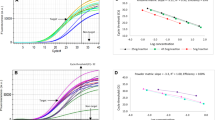Abstract
Almond (Prunus dulcis), typically used in marzipan, is becoming more valuable by increasing global demand. As a consequence, substitution with cheaper alternatives is a common practice. Marzipan can be adulterated with apricot (Prunus armeniaca) or peach (Prunus persica), because of similar characteristics. Both species are closely related to almond; however, small differences in non-specific lipid transfer protein (LTP), used as target sequence for a qPCR test, can be noticed. In this study, a TaqMan qPCR method for specific detection of apricot in marzipan was developed. After optimization, specificity and sensitivity tests were carried out on real samples and the limit of detection was determined. The TaqMan qPCR method showed high specificity for apricot and was able to detect as low as 1% persipan in marzipan.


Similar content being viewed by others
References
Arumuganathan K, Earle ED (1991) Nuclear DNA content of some important plant species. Plant Mol Biol Report 9:208–218
Baird WV, Estager AS, Wells JK (1994) Estimating nuclear DNA content in peach and related diploid species using laser flow cytometry and DNA hybridization. J Am Soc Hortic Sci 119:1312–1316
Boukhchina S, Sebai K, Cherif A, Kallel H, Mayer PM (2004) Identification of glycerophospholipids in rapeseed, olive, almond, and sunflower oils by LC-MS and LC-MS-MS. Can J Chem 82:1210–1215
Brezna B, Smid J, Costa J, Radvanszky J, Mafra I, Kuchta T (2015) In silico and experimental evaluation of DNA-based detection methods for the ability to discriminate almond from other Prunus spp. Mol Cell Probes 29:99–115
Bruning P, Haase I, Matissek R, Fischer M (2011) Marzipan: polymerase chain reaction-driven methods for authenticity control. J Agric Food Chem 59:11910–11917
Costa J, Mafra I, Beatriz M (2012) High resolution melting analysis as a new approach to detect almond DNA encoding for Pru du 5 allergen in foods. Food Chem 133:1062–1069
Davidson A (1999) The Oxford companion to food, First Edition edn. Oxford university press, Oxford
Gurfinger T, Letan A (1973) Detection of adulteration of almond oil with apricot oil through determination of tocopherols. J Agric Food Chem 21:1120–1123
Haase I, Bruning P, Matissek R, Fischer M (2013) Real-time PCR assays for the quantitation of rDNA from apricot and other plant species in marzipan. J Agric Food Chem 61:3414–3418
Janick J, Schery RW, Woods FW, Ruttan VW (1974) Plant science. An introduction to world crops, Second Edition edn. W. H. Freeman, San Francisco
Kirchhoff E, Weber W, Kleinert T, Kruse L, Meyer G, Mueller M (1998) Detection and determination of apricot kernels in marzipan products by using isoelectric focusing and PCR. Deutsche Lebensmittel-Rundschau 94:132–127
Leitsätze für Ölsamen und daraus hergestellte Massen und Süßwaren (2010) Deutsche Lebensmittelbuch-Kommission, BAnz, No. 239a
Lockley AK, Bardsley RG (2000) DNA-based methods for food authentication. Trends Food Sci Technol 11:67–77
López-Calleja IM, de la Cruz S, Pegels N, González I, Martín R, García T (2014) Sensitive and specific detection of almond (Prunus dulcis) in commercial food products by real-time PCR. LWT Food Sci Technol 56:31–39
Luber F, Demmel A, Hosken A, Busch U, Engel KH (2012) Apricot DNA as an indicator for persipan: detection and quantitation in marzipan using ligation-dependent probe amplification. J Agric Food Chem 60:5853–5858
Mafra I, Ferreira IPLVO, MBP O (2008) Food authentication by PCR-based methods. Eur Food Res Technol 227:649–665
Potter D et al (2007) Phylogeny and classification of Rosaceae. Plant Syst Evol 266:5–43
Roder M, Vieths S, Holzhauser T (2011) Sensitive and specific detection of potentially allergenic almond (Prunus dulcis) in complex food matrices by Taqman real-time polymerase chain reaction in comparison to commercially available protein-based enzyme-linked immunosorbent assay. Anal Chim Acta 685:74–83
Salcedo G, Sanchez-Monge R, Barber D, Diaz-Perales A (2007) Plant non-specific lipid transfer proteins: an interface between plant defence and human allergy. Biochim Biophys Acta 1771:781–791
U.S. Department of Agriculture ARS (2014) USDA National Nutrient Database for Standard Reference, Release 28. Nutrient Data Laboratory Home Page, http://www.ars.usda.gov/nutrientdata. Accessed 18/01/2016
Van Gansbeke B (2012) Private communication Markelbach & Corne. Wilrijk, Belgium
Weber W, Hauser W (2007) Bestimmung von Aprikosenkernbestandteilen in Marzipan und Marzipanvorstuten mittels Realtime-(Sonden)-PCR. Deutsche Lebensmittel-Rundschau 107:416–418
Zlatanov M, Janakieva I (1998) Phospholipid composition of some fruit-stone oils of Rosaceae species. Lipid / Fett 100:312–315
Acknowledgements
The authors would like to thank Markelbach & Corne group, and especially Eric Van Gansbeke and his team for providing the samples of the almonds, apricot kernels, persipan and marzipan. We also thank SVZ Rijkevorsel NV for providing the sour cherry kernels. Furthermore, the first author thanks Dr. Corinne Vander Wauven who kindly guided him into the theoretical part of his master thesis.
Author information
Authors and Affiliations
Corresponding author
Ethics declarations
Funding
This study was funded by the ILVO. ILVO is a governmental body, and this research is a part of the social commitment towards the society.
Conflict of Interest
Bart Van Gansbeke declares that he has no conflict of interest. Abhishek Dutta declares that he has no conflict of interest. Guido Bény declares that he has no conflict of interest. Marc De Loose declares that he has no conflict of interest. Isabel Taverniers declares that she has no conflict of interest.
Ethical Approval
This article does not contain any studies with human participants or animals performed by any of the authors.
Informed Consent
Not applicable.
Rights and permissions
About this article
Cite this article
Van Gansbeke, B., Bény, G., De Loose, M. et al. A TaqMan Real-Time PCR Assay for Apricot (Prunus armeniaca) as an Authenticity Test for Detection of Traces of Persipan in Marzipan. Food Anal. Methods 11, 62–68 (2018). https://doi.org/10.1007/s12161-017-0964-5
Received:
Accepted:
Published:
Issue Date:
DOI: https://doi.org/10.1007/s12161-017-0964-5




